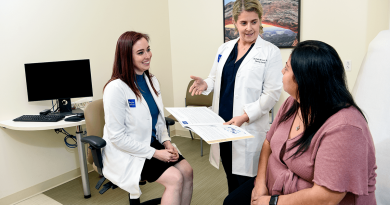What you need to know about heart failure
Heart failure is an umbrella term that covers many conditions. The American Heart Association defines heart failure as a chronic, progressive condition in which the heart muscle is unable to pump enough blood to meet the body’s needs for blood and oxygen. According to the CDC, more than 6 million Americans have heart failure, and it costs the nation more than $30 billion per year. The global prevalence and costs are 10 times that amount.
 Symptoms of heart failure are all related to the inability of the heart to pump enough blood or oxygen to the body. Common symptoms include shortness of breath, fatigue, edema (swelling of the feet or ankles), rapid heart rate, reduced tolerance for exercise, “brain fog,” erectile dysfunction and late-stage symptoms such as pulmonary hypertension, poor appetite and weight loss.
Symptoms of heart failure are all related to the inability of the heart to pump enough blood or oxygen to the body. Common symptoms include shortness of breath, fatigue, edema (swelling of the feet or ankles), rapid heart rate, reduced tolerance for exercise, “brain fog,” erectile dysfunction and late-stage symptoms such as pulmonary hypertension, poor appetite and weight loss.
Fortunately, there are many ways to treat heart failure. Early treatment consists of medications such as ACE inhibitors, ARBs, beta-blockers and diuretics. The newest class of medications, called ARNIs, have been shown to reduce both death and additional complications. Any of these medications can be used in combination and are often called a heart failure cocktail. Cardiologists can now implant devices like the CardioMEMS that provide continuous and direct measurement of heart failure parameters to improve quality of life and symptom control. This is an internal implantable device that can track your heart rate, rhythm, blood pressure and oxygenation.
In cases of advanced heart failure, there are also surgical options. One of those is a left ventricular assist device (LVAD), which is an implantable pump that assists your heart by pushing blood out to the body. The LVAD is controlled by a line that exits the upper abdomen and connects to a controller and external power supplies. Data has shown that these devices can not only extend overall survival but also improve quality of life. Another surgical option is a heart transplant where a surgeon removes your failing heart and replaces it with a donor organ.

Daniel Kay has had heart failure for 10 years and it progressed to where he was very uncomfortable sitting and even laying down. He was not able to breathe well, his legs would swell and he had low energy. Doctors told him without surgery, he would only live one or two years. In June, Daniel had an LVAD implanted and is now on the heart transplant list.
Daniel relies on his wife and stepdaughter to help change the dressings and make sure his lines are covered for showers. “It takes a lot of patience and dedication,” Daniel says. “My wife and stepdaughter spent extensive time at the VA learning how to change dressings and use the batteries.”
His advice to people with heart failure: “Listen to the doctors. Do the things they tell you to do – take your medicine, exercise, cut down on the salt and sugar.”
If you have any symptoms or suspect heart failure, reach out to your primary care provider to discuss a referral to a cardiologist. They can do additional testing such as an echocardiogram and/or right heart catheterization. These tests are minimally invasive and provide necessary diagnostic information. An echocardiogram is an ultrasound of the heart to look at the structure and function of the chambers, valves, and muscles. A right heart catheterization is done under sedation and the healthcare provider will look at the structure, function, and pressures of the heart through a small catheter in the groin or neck. These tests can diagnose or rule out heart failure and then guide treatment.
Learn about our cardiovascular services.
By Michael Sheehan, instructor and nurse practitioner in the Department of Surgery – Division of Cardiothoracic Transplantation and Circulatory Support, and Tiffany Harston, communications specialist.



